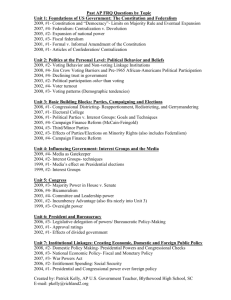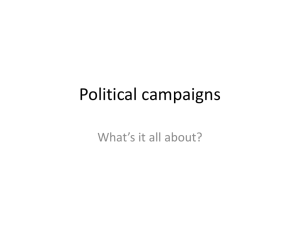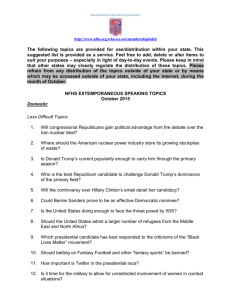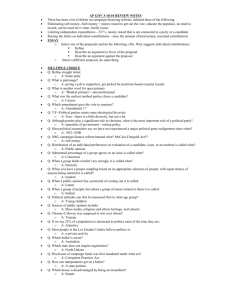Elections and Campaigns #4 Which of the following statements
advertisement
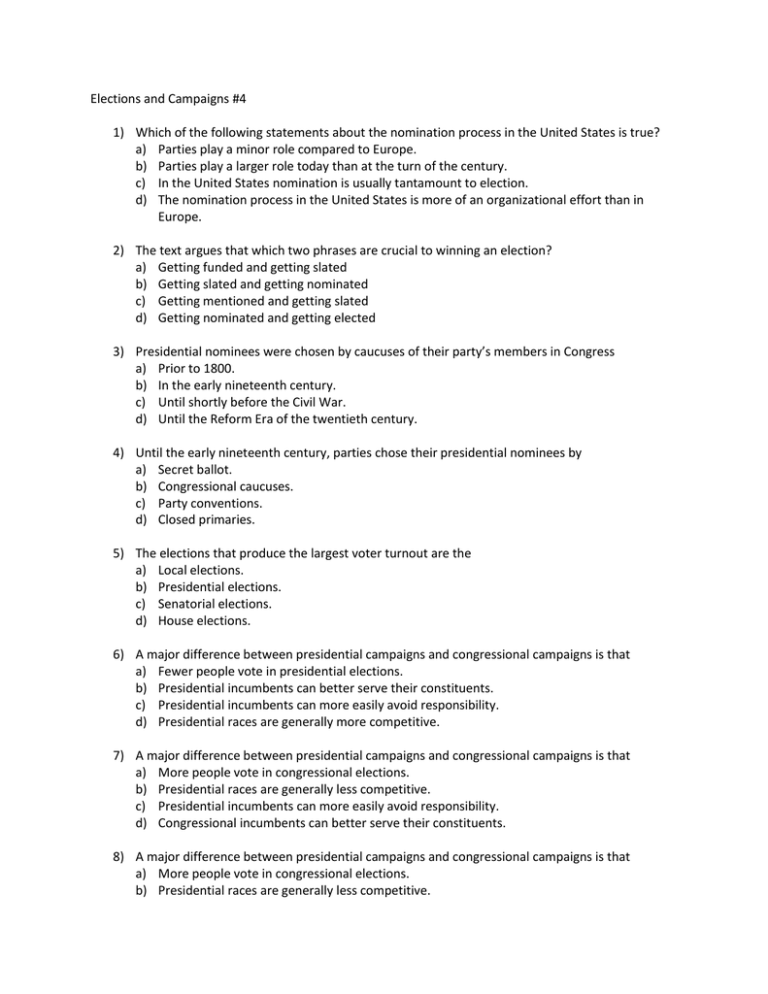
Elections and Campaigns #4 1) Which of the following statements about the nomination process in the United States is true? a) Parties play a minor role compared to Europe. b) Parties play a larger role today than at the turn of the century. c) In the United States nomination is usually tantamount to election. d) The nomination process in the United States is more of an organizational effort than in Europe. 2) The text argues that which two phrases are crucial to winning an election? a) Getting funded and getting slated b) Getting slated and getting nominated c) Getting mentioned and getting slated d) Getting nominated and getting elected 3) Presidential nominees were chosen by caucuses of their party’s members in Congress a) Prior to 1800. b) In the early nineteenth century. c) Until shortly before the Civil War. d) Until the Reform Era of the twentieth century. 4) Until the early nineteenth century, parties chose their presidential nominees by a) Secret ballot. b) Congressional caucuses. c) Party conventions. d) Closed primaries. 5) The elections that produce the largest voter turnout are the a) Local elections. b) Presidential elections. c) Senatorial elections. d) House elections. 6) A major difference between presidential campaigns and congressional campaigns is that a) Fewer people vote in presidential elections. b) Presidential incumbents can better serve their constituents. c) Presidential incumbents can more easily avoid responsibility. d) Presidential races are generally more competitive. 7) A major difference between presidential campaigns and congressional campaigns is that a) More people vote in congressional elections. b) Presidential races are generally less competitive. c) Presidential incumbents can more easily avoid responsibility. d) Congressional incumbents can better serve their constituents. 8) A major difference between presidential campaigns and congressional campaigns is that a) More people vote in congressional elections. b) Presidential races are generally less competitive. c) Presidential incumbents can better serve their constituents. d) Congressional incumbents can more easily avoid responsibility. 9) Presidential races differ from congressional races in that the former generally a) Produce a smaller voter turnout. b) Relate more closely to what the candidate can do for constituents. c) Are more competitive. d) Allow the incumbent more opportunity to deny responsibility for the “mess” in Washington. 10) Presidential races differ from congressional races in that the former generally a) Are less competitive. b) Relate more closely to what the candidate can do for constituents. c) Produce a larger voter turnout. d) Allow the incumbent more opportunity to deny responsibility for the “mess” in Washington. 11) Presidential races differ from congressional races in that the former generally a) Are less competitive. b) Relate more closely to what the candidate can do for constituents. c) Allow the incumbent less opportunity to deny responsibility for the “mess” in Washington. d) Produce a smaller voter turnout. 12) Which of the following statements best summarizes the value of presidential coattails to congressional candidates of the same party? a) It has never been a significant factor. b) It remains a significant factor today. c) It is becoming much less significant today. d) It is becoming more significant today. 13) It has been said that the first task facing anyone who wishes to become president is to a) Get mentioned. b) Get funded. c) Be accepted by party leaders. d) Become well known to the voters. 14) The first goal of an individual planning to run for office is to a) Hire a paid staff of advisers. b) Get mentioned as a possible candidate. c) Develop a strategy for the campaign. d) Raise money for individuals and political action committees (PACs). 15) Ronald Reagan made a dozen speeches a day to audiences all over the country while a) His acting career was in full swing. b) Working for General Electric. c) Running for president in 1980. d) Running for president in 1984. 16) For a presidential primary candidate to be eligible for federal matching funds, he or she must first a) b) c) d) Raise a total of $50,000 from individual and other donors in each of twenty states. Have the validated signatures of at least 5,000 registered voters in each of twenty states. Raise $5,000, in individual contributions of $250 or less, in each of twenty states. Have the validated signatures of at least 50,000 registered voters in each of twenty states. 17) The campaign organization set up by a presidential candidate typically consists of all of the following except a) A group of political action committee (PAC) and union leaders. b) A paid staff of fundraisers, lawyers, accountants, and others. c) A volunteer staff from several key states. d) A number of advisers on key issues. 18) Which of the following groups are truly essential to a presidential campaign organization? a) Fundraisers, accountants, and lawyers b) Advertising, direct mail, and polling specialists c) Volunteers and advisers d) All of the above 19) One reason why the approach used by a candidate in a general election may not work in a primary is that a primary candidate must a) Take a more mainstream view of key issues. b) Be more aware of the “clothespin” vote. c) Play to the ideology of political activists. d) Take greater caution to avoid slips of the tongue. 20) To win the presidential nomination, as opposed to the general election, candidates generally present themselves as a) More conservative. b) More liberal. c) More liberal if Republican, more conservative is Democratic. d) More liberal is Democratic, more conservative if Republican. 21) Usually the first crucial test of strength in a presidential campaign comes in a) The South. b) Vermont. c) New Hampshire. d) Iowa. 22) Iowa holds the distinctive position in presidential races of having the first a) Test of candidates’ appeal. b) Open primary. c) Closed primary. d) Regional primary. 23) In the 1980 presidential election, many voters voted for Ronald Reagan over Jimmy Carter as a vote against Carter, not out of loyalty to Reagan. Such a vote is referred to as a(n) a) Spin vote. b) Clothespin vote. c) Prospective vote. d) Informed vote. 24) George McGovern was at a disadvantage in the presidential election of 1972 because he had, while winning his party’s nomination, a) Take ideologically extreme positions. b) Spent his way to near bankruptcy. c) Responsibility for the legacy of the previous administration. d) Been handpicked by party leaders. 25) An example of a presidential candidate who too such strong stands to win the nomination that he was at a disadvantage in the general election is a) George McGovern. b) Hubert Humphrey. c) Gerald Ford. d) George Bush. 26) A _______ issue is one in which the rival candidates have opposing views on a question that also divides the voters. a) Valence b) Primary c) Secondary d) Position 27) In the 2000 election, George W. Bush wanted to let people put some of their Social Security money into private savings accounts; Al Gore opposed this. This is an example of a ______ issue. a) Valence b) Primary c) Secondary d) Position 28) A _______ issue is one in which a candidate fully supports the public’s view on a matter about which nearly everybody is in agreement. a) Valence b) Primary c) Secondary d) Position 29) An example of a _______ issue was when Jimmy Carter seemed more likely to favor honesty in government than did his opponent in 1976. a) Valence b) Primary c) Secondary d) Position 30) _______ issues have increased in importance in campaigns in recent years. a) Valence b) Primary c) Secondary d) Position 31) In the 1968 presidential election, during the height of the Vietnam War, many antiwar voters found neither Richard Nixon nor Hubert Humphrey appealing. The vote they cast is referred to as a(n) a) Spin vote. b) Clothespin vote. c) Waste vote. d) Informed vote. 32) The kind of campaign activity most notably on the increase in recent elections is a) Broadcasting. b) Large parades and rallies. c) Whistle-stop train tours. d) Appearances at factories and malls. 33) Which of the following statements about television spot ads in general elections is true? a) They manipulate voters very effectively. b) They have almost no effect, as far as can be determined. c) They usually help the Republican candidate. d) They are being used less and less frequently. 34) The least effective form of television exposure for candidates is apparently the a) Debate. b) New item. c) Spot ad. d) Negative ad. 35) Research suggests that the role of television advertising spots in determining the outcome of an election is a) Minimal. b) Very important in primaries, less so in general elections. c) Very important in general elections, less so in primaries. d) Important in both primaries and general elections. 36) Which of the following statements about the impact of television advertising is probably true? a) It is greater for clarifying issues than for projecting an image. b) It is more pronounced in congressional than in presidential races. c) It is greater on primary elections than on general elections. d) It is greater on general elections than on primary elections. 37) Candidates are most at risk of verbal slips in the televised a) Visual. b) Spot ad. c) Stock speech. d) Debate. 38) The drawback to candidates of television visuals and debates is a) Their time limitations. b) The risk of verbal slips. c) Their expense. d) Audience passivity. 39) Compared with paid television advertising, television visuals such as an appearance by a candidate on the nightly news are probably a) More expensive. b) Less credible with voters. c) Less informative. d) Less influential on election outcomes. 40) One way for a candidate to avoid embarrassing slips of the tongue during campaigning is to a) Engage in televised debates. b) Avoid paid advertising. c) Rely on stock speeches. d) Control the timing of visuals. 41) One effect of candidates’ fear of a slip during campaigning is that, increasingly, candidates are a) Relying on television debates to clarify their views. b) Selling an image rather than their ideas. c) Avoiding stock speeches in favor of impromptu briefings. d) Avoiding television exposure altogether. 42) According to polls, after the television debates in the 1992 campaign, Ross Perot’s support a) Doubled. b) Was unchanged. c) Slipped a small percentage. d) Dropped 50 percent. 43) The positive effect of television is best illustrated by the 1992 campaign of a) Bill Clinton. b) George Bush. c) Ross Perot. d) None of the candidates. 44) Assume you are running for office on the Greenbelt ticket and need to reach all of the environmentalists in your area. Your best bet is to rely on a a) Paid television ad. b) Direct mailing. c) News broadcast. d) Televised debate. 45) An advantage of direct-mail appeals is that they a) Cost very little. b) Can be directed at specific subgroups of the populations. c) Can blanket the entire electorate. d) Reach only the literate. 46) Unlike congressional campaigns, presidential campaigns are funded by a) Private sources only. b) Public sources only. c) Both private and public sources. d) Federal matching grants only. 47) The costs of a general election for each major party are covered by a) The government, up to $55 million. b) Private funds raised by the party. c) Taxpayers, through a tax return check-off box. d) Each state in which the candidate is entered. 48) The government contributes matching funds to presidential candidates. These funds match a) All private funds raised by a candidate. b) Donations from all individuals and political action committees (PACs). c) All contributions from the party. d) Donations of less than $250 only. 49) One effect of the way that federal matching funds are made available to candidates for presidential campaigns is to a) Give candidates an incentive to raise money from small donors. b) Encourage candidates to use more of their own financing. c) Strengthen the role that the party plays in raising campaign funds. d) Increase the chances of an ideologically oriented candidate winning the election. 50) Funding of congressional elections comes from a) Public sources only. b) Private sources only. c) Party sources only. d) A combination of public, party, and private sources. 51) The limit set on the amount any person can contribute to a single candidate by the 1974 campaign-finance reform law was a) $100. b) $1,000. c) $10,000. d) $50,000. 52) Not a good question 53) Prior to the 1974 campaign finance reforms, which of the following statements about corporate and union contributions to candidates was correct? a) They were strictly forbidden and vigorously prosecuted. b) They had been illegal since 1925, but the law had been unenforceable. c) They were not illegal and were commonly made. d) They were not illegal, but few corporations and unions made such contributions. 54) Although political action committees (PACs) themselves are limited by law in the amount they can contribute to campaigns, they can legally circumvent this limitation by a) Contributing a smaller amount to the candidate they oppose. b) Raising money from their members or employees. c) Giving to both a presidential and vice presidential candidate. d) Applying for a one-time waiver of the limitation. 55) Current finance rules for campaigns give a major financial advantage to a) Incumbents. b) Challengers. c) Neither incumbents nor challengers. d) Independents. 56) One major difference between incumbents and challengers in the financing of their campaigns is that incumbents rely a) Much less on political action committee (PAC) funds and much more on party money. b) On a combination of public and private funds. c) Much more on political action committee (PAC) funds and much less on their own money. d) Entirely on public funds. 57) The legal limit on what a congressional candidate may spend is a) Nonexistent. b) $1 million. c) $5 million. d) $10 million. 58) An example of independent political advertising by a political action committee (PAC) would be a a) Television debate sponsored by the League of Women Voters. b) Direct mailing of a letter, under a candidate’s signature, stating the candidate’s position on oil. c) Visual that shows a candidate helping special needs children. d) Television spot that attacks one candidate’s stand on defense without mentioning the other candidate. 59) Assume you are a presidential candidate with enormous personal wealth. You can legally circumvent the government’s $50,000 limit on personal spending by a) Refusing federal financing. b) Spending for direct mailing only. c) Contributing to a political action committee (PAC), which in turn contributes a greater amount to your campaign. d) Forming a PAC. 60) A congressional candidate raised millions of dollars, without regard to FEC limits, for a campaign to facilitate voting by the elderly. Has this candidate broken the law? a) No, because the candidate does not have to accept federal financing. b) No, because the money was not spent on advertising on the candidate’s behalf. c) No, because this type of fundraising is considered a party activity. d) Yes, because FEC laws strictly prohibit this type of activity. 61) The Hoboken Democratic Party raises thousands of dollars from local corporations, without regard to FEC limits, for a campaign to register voters. Has the party broken the law? a) No, because the party does not have to accept federal financing. b) No, because the money was not spent on advertising on a candidate’s behalf. c) No, because parties are exempt from FEC campaign regulations. d) Yes, because FEC laws strictly prohibit this type of activity. 62) The primary goal of the 1974 campaign finance reforms was to a) Give greater power to political action committees (PACs) and less to individuals. b) Shift the burden of financing elections from the government to the candidates and parties. c) Reduce the influence of fat cats in elections. d) Shift the burden of financing elections from the federal government to state governments. 63) Not a good question 64) Not a good question 65) Among the expected effects of the campaign-finance reform are all of the following except a) Candidates who are not rich will have to devote more time to raising funds and less to campaigning. b) Late starters may be discouraged from getting into the campaign. c) Incumbents will enjoy an advantage in fundraising. d) Political parties will be strengthened. 66) Early birds, incumbents, and rich challengers are all given an advantage by the current a) Campaign finance reforms. b) Proportionality system. c) Winner-take-all system. d) Caucus/primary division. 67) According to the text, higher campaign spending in congressional elections appears to produce more votes for a) The challenger. b) The incumbent. c) Neither the challenger nor the incumbent. d) Both the challenger and the incumbent. 68) One advantage that incumbents always have over challengers is a) Their larger share of federal campaign monies. b) The political advantage of riding the president’s coattails. c) Their use of free mailings, or franks. d) Their freedom from FEC regulations. 69) Many scholars argue that the foremost factor in determining how people vote is a) Party identification. b) Perception of the best candidate. c) Campaign spending. d) The candidate’s image. 70) If party identification alone determined election outcomes, which party would win? a) The Republicans usually b) The Republicans always c) The Democrats usually d) The Democrats always 71) Democrats could be predicted to win every election if the only factor were a) Candidate appeal. b) Campaign issues. c) Party identification. d) Money spent. 72) Which party tends to be more loyal to its candidate in presidential elections? a) Democrats b) Republicans c) Independents d) No clear-cut difference exists among the parties 73) Which party tends to do better in competing for the vote of self-described independents? a) Republicans do much better than Democrats. b) Republicans do slightly better than Democrats. c) Democrats do much better than Republicans. d) Democrats do slightly better than Republicans. 74) In presidential races, Republicans consistently outperform Democrats in a) Creating excitement among the electorate. b) Having more voters register. c) Winning the independent vote. d) Translating support to congressional races. 75) Not a good question 76) Voters are most likely to switch parties between elections when a) It serves their self-interest. b) The economy is relatively strong. c) The country is at war. d) It means switching to the party in power. 77) Prospective voting involves a) Taking a chance on a new candidate. b) Picking the incumbent over the challenger. c) Picking the challenger over the incumbent. d) Voting according to future expectations. 78) A voter has a strong interest in local politics and knows how each candidate stands on key issues. This voter is known as a(n) a) Analytic voter. b) Prospective voter. c) Retrospective voter. d) Activist voter. 79) When a voter votes for the candidate whom he or she considers more likely to do a better job in office, the voting is referred to as a) Clothespin voting. b) Ideological voting. c) Prospective voting. d) Retrospective voting. 80) “I’m voting for Challenger Goodbrain because I like her views on the environment, social welfare, and revenue sharing.” Such a vote is called a) Prospective. b) Quid pro quo. c) Matching. d) Preemptive. 81) Retrospective voting involves a) Voting for the best candidate. b) Basing your vote on past performance. c) Voting consistently for the same party. d) Splitting your ticket. 82) When a voter votes based on how things have been going and which party is in power, it is referred to as a) Issueless voting. b) Ideological voting. c) Prospective voting. d) Retrospective voting. 83) “I’m voting for Congresswoman Goodjob because she got us that new defense contract. And I think she’s performing well overall.” Such a vote is called a) Quid pro quo. b) Matching. c) Retrospective. d) Preemptive. 84) Retrospective voting generally helps an incumbent except a) When congressional and presidential elections overlap. b) When party activists play a limited role in a campaign. c) When issues are secondary to perceptions in a campaign. d) When the economy has gotten worse. 85) Campaigns do make a difference because they a) Emphasize details and issues over themes and perceptions. b) Let voters judge a candidate’s character and values. c) Reduce the influence of single-issue groups. d) Counteract the effects of party loyalty and national economic conditions. 86) Campaigns do make a difference because they a) Emphasize details and issues over themes and perceptions. b) Give voters a chance to see how candidates handle pressure. c) Reduce the influence of single-issue groups. d) Counteract the effects of party loyalty and national economic conditions. 87) Several factors have contributed to the emphasis on themes over details in recent elections. One of these factors is the a) Desire of voters to discern candidate character. b) Rise in prospective voting. c) Increase in the number of televised debates and visuals. d) Campaign finance reforms of 1974. 88) Several factors have contributed to the emphasis on themes over details in recent elections. One of these factors is the a) Increased use of short radio and television ads. b) Rise in prospective voting. c) Increase in the number of televised debates and visuals. d) Campaign finance reforms of 1974. 89) Several factors have contributed to the emphasis on themes over details in recent elections. One of these factors is the a) Increased use of computer-targeted direct mail. b) Rise in prospective voting. c) Increase in the number of televised debates and visuals. d) Campaign finance reforms of 1974. 90) Although campaigns in the United States have historically emphasized broad themes over specific details, what has emerged in recent years is the a) Power of political parties. b) Influence of political fat cats. c) Importance of primary elections. d) Impact of major political realignments. 91) The text points out that the term sleeping giant can best be applied to the a) Black vote. b) Hispanic vote. c) Asian-American vote. d) Evangelical vote. 92) The Hispanic vote is chiefly located in which three states? a) Texas, New York, Connecticut b) New York, Connecticut, California c) Connecticut, California, Texas d) New York, Texas, California 93) The Democrats have lost their once-strong hold on all of the following except a) Catholics. b) Southerners. c) Union members. d) Blacks. 94) In numbers rather than percentages, the smallest contribution to Democratic vote totals is made by a) Union members. b) Blacks. c) Catholics. d) Southerners. 95) Union leaders, in making demands on Democratic leaders and candidates, will usually emphasize a) The loyalty of their followers to the party. b) Labor’s willingness to form a factional party if necessary. c) The contributions of labor to the New Deal. d) The large numbers of union voters. 96) The Republican party was clearly the dominant party from a) 1896 to 1932. b) 1916 to 1948. c) 1932 to 1960. d) 1948 to 1968. 97) Fundamental realignments of the major parties seems to have occurred in each of the following elections except a) 1860. b) 1896. c) 1932. d) 1968. 98) Party realignment seems to have been most closely related to a) Shifting demographic patterns. b) Decisions taken within party organizations. c) New and important issues. d) Federal election laws. 99) The 1860, 1896, and 1932 elections are clear examples of a) Maintaining elections. b) Deviating elections. c) Realigning elections. d) Converting elections. 100) Party realignments most often occur as a result of strong disagreements over real issues. An example of an issue that caused a realignment is a) b) c) d) The War of 1812, which split the Federalist Party in half. Slavery in 1860, which split the Democratic Party in half. The gold crisis of 1910, which split the Republican Party in half. The civil rights movement of the 1960s, which split the Democratic Party in half. 101) Redundant question 102) Redundant question 103) a) b) c) d) Ronald Reagan won in 1980 primarily because The electorate voted prospectively. Voters were pleased with the economic climate. Voters were dissatisfied with Jimmy Carter. The country had moved to the right. 104) a) b) c) d) Ronald Reagan won in 1984 primarily because The electorate voted prospectively. Voters were pleased with the economic climate. Voters were dissatisfied with Jimmy Carter. The country had moved to the right. 105) A retrospective vote against the incumbent seems to have been a significant factor in the presidential election of a) 1968. b) 1972. c) 1980. d) 1984. 106) a) b) c) d) The one dramatic shift in presidential voting patterns since 1972 has been among Women, who have grown increasingly Democratic and independent. Blacks, who have grown increasingly Republican and independent. Hispanics, who have grown increasingly Democratic and independent. Southerners, who have grown increasingly Republican and independent. 107) a) b) c) d) Split-ticket voting was not possible in the United States until the Massachusetts ballot replaced the Indiana ballot. Australian ballot was adopted. Campaign reform laws of 1974 went into effect. Party-column ballot was adopted. 108) a) b) c) d) The office-bloc ballot made it possible for voters for the first time to Vote in secret. Connect party labels to candidates’ names. Cast a straight-party vote. Split their votes between party tickets. 109) One major effect of ticket-splitting in national elections is a(n) a) Increase in the frequency of major party realignments. b) Divided government, in which one party controls the presidency; the other, Congress. c) Decrease in the number of races in which the two candidates are separated by less than ten percentage points. d) Gradual emergence of parties as a political force. 110) Elections often have major effects on public policy in Great Britain, arguably because of Great Britain’s a) More homogeneous population. b) Longer period under constitutional government. c) Parliamentary system with strong parties. d) High standard of economic development. 111) a) b) c) d) Great Britain’s parliamentary system seems to produce at relatively regular intervals A deadlock of legislative and executive powers. Elections that lead to major policy changes. Disputed elections to be decided in court. A government unable to act at all. 112) The U.S. constitutional system was designed to make the adoption of radical departures in policy a) Difficult. b) Easy. c) Impossible. d) Unnecessary. 113) An election that brought about wide-scale adoption of social assistance programs was that in a) 1956. b) 1964. c) 1972. d) 1980. 114) An election that brought about a significant reduction in taxes, spending, and regulatory practices was that in a) 1956. b) 1964. c) 1976. d) 1980. 115) One study of some 1,400 promises made in political parties’ platforms between 1944 and 1964 found that some __________ percent of them were kept. a) 12 b) 37 c) 52 d) 74 116) Which of the following statements is true about most presidential elections? a) b) c) d) They do not produce any major party realignment. They are generally decided by prospective voting patterns. They generally provide the winner with a clear mandate. They are usually fought over a dominant issue. 117) a) b) c) d) Which of the following statements is true about most presidential elections? They are decided by retrospective voting. They produce a major party realignment. They provide the winner with a clear mandate. They are fought over a dominant issue. 118) a) b) c) d) Which of the following statements is true about most presidential elections? They do not provide the winner with a clear mandate. They produce a major party realignment. They are decided by prospective voting patterns. They are fought over a dominant issue. 119) a) b) c) d) Which of the following statements is true about most presidential elections? They are not fought over a dominant issue. They provide the winner with a clear mandate. They produce a major party realignment. They are not decided by retrospective voting. ANSWERS 1) 2) 3) 4) 5) 6) 7) 8) 9) 10) 11) 12) 13) 14) 15) 16) 17) 18) 19) 20) 21) 22) 23) 24) 25) 26) 27) 28) 29) 30) 31) 32) 33) 34) 35) 36) 37) 38) 39) 40) A D B B B D D D C C C C A B B C A D C D D A B A A D D A A A B A B C A D D B C C 41) 42) 43) 44) 45) 46) 47) 48) 49) 50) 51) 52) 53) 54) 55) 56) 57) 58) 59) 60) 61) 62) 63) 64) 65) 66) 67) 68) 69) 70) 71) 72) 73) 74) 75) 76) 77) 78) 79) 80) 81) 82) B A C B B C A D A B B N/A B B A C A D A B B C N/A N/A D A D C A D C B A C N/A A D B C A B D 83) C 84) D 85) B 86) B 87) A 88) A 89) A 90) C 91) B 92) D 93) D 94) B 95) D 96) A 97) D 98) C 99) C 100) 101) 102) 103) 104) 105) 106) 107) 108) 109) 110) 111) 112) 113) 114) 115) 116) 117) 118) 119) B N/A N/A C B C D A D B C B A B D D A A A A


